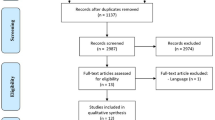Abstract
Data sources The Cochrane Library, MEDLINE (1966–2002), EMbase (1980–2002) and searches by hand were used to identify relevant studies.
Study selection Randomised controlled trials (RCT) or quasi-RCT were selected that compared occlusal adjustment with placebo or reassurance or no treatment in adults who had TMD. The outcomes were global measures of symptoms, pain, headache and limitation of movement.
Data extraction and synthesis Data were independently extracted by two reviewers, the authors were contacted for details of randomisation and withdrawals and a quality assessment was carried out. The Cochrane Oral Health Group's statistical guidelines were followed. From the data provided in the published reports, symptom-based outcomes were extracted from trials that studied treatment. Data for the incidence of symptoms were extracted from trials on prevention.
Results More than 660 trials were identified by the initial search. Six of these trials (392 patients), were suitable for inclusion. No differences were found between occlusal adjustment and control groups.
Conclusions There is an absence of evidence, from RCT, that occlusal adjustment treats or prevents TMD. Occlusal adjustment cannot be recommended for the management or prevention of TMD. Future trials should use standardised diagnostic criteria and outcome measures when evaluating TMD.
Similar content being viewed by others
Commentary
Systematic searches for evidence to support the current treatment practices in TMD are few, so far. This Cochrane review, which seeks to discover whether there is evidence for the use of occlusal adjustment to treat or prevent TMD is therefore an important contribution to the field. The question presented by the authors is highly relevant given the controversies around the subject. Despite the fact that the significance of occlusal factors as contributors to the aetiology of TMD is not known, indeed remaining one of the most debated topics in dentistry, occlusal adjustment is widely used for treatment of TMD.
The criteria for considering studies for the review, the search strategy to locate the original studies, and the data collection and analysis are all carefully described in the review to allow critical appraisal. In all, 17 studies were considered eligible according to the defined criteria. Of these, 11 trials were excluded for various reasons. These reasons are, unfortunately, inconsistently described. Three of the trials included, considered occlusal adjustment in treating patients with TMD: the other three considered the prevention of TMD using occlusal adjustment. The results of the trials are presented as effect-sizes, which have the disadvantage of not being intuitive for clinicians. The conclusions are clear, however. Occlusal adjustment was found not to significantly reduce any of the symptom-based outcomes. Neither did occlusal adjustment reduce the incidence of TMD symptoms significantly in the prevention studies.
Although they note the absence of evidence supporting the use of occlusal adjustment, the authors quite rightly remind the readers that this is not necessarily evidence of a lack of effect but a clear indication that more research is needed to elucidate whether there is any benefit from treating TMD with occlusal adjustment. For the present, their conclusion that occlusal adjustment cannot be recommended in the treatment and prevention of TMD is justified. The results are in line with the results of a previous systematic review on occlusal treatments in TMD.1 A very valuable point of the present review is the recommendations for future trials. The authors recommend the use of valid and standardised diagnostic criteria for TMD, the use of standardised outcome measures, use of adequate study groups based on power calculation and the reporting of cost–outcome comparisons as well as reporting of side effects.
Practice point
-
At present, there is no evidence to support occlusal adjustment in the treatment or prevention of TMD.
References
Forssell H, Kalso E, Koskela P, Vehmanen R, Puukka P, Alanen P . Occlusal treatments in temporomandibular disorders. A qualitative systematic review of randomized controlled trials. Pain 1999; 83:549–561.
Author information
Authors and Affiliations
Additional information
Address for correspondence: Emma Tavender, Review Group Co-ordinator, Cochrane Oral Health Group, University Dental Hospital of Manchester, Higher Cambridge Street, Manchester M15 6FH, UK. E-mail: emma.tavender@man.ac.uk
Koh H, Robinson PG. Occlusal adjustment for treating and preventing temporomandibular joint disorders (Cochrane Review). The Cochrane Library 2003; Issue 1. Oxford: Update Software
Rights and permissions
About this article
Cite this article
Forssell, H. There is no evidence to support use of occlusal adjustment for prevention or treatment of TMD. Evid Based Dent 4, 32 (2003). https://doi.org/10.1038/sj.ebd.6400177
Published:
Issue Date:
DOI: https://doi.org/10.1038/sj.ebd.6400177



